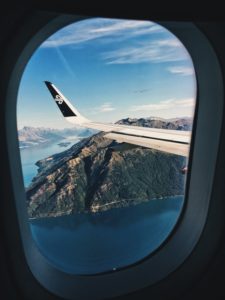 I recently arrived home from an Alaskan cruise I went on with my spouse and extended family. It was a wonderful trip that I’ll talk more about in various posts over the next couple of weeks, but I have missed connecting with everyone in the blogosphere.
I recently arrived home from an Alaskan cruise I went on with my spouse and extended family. It was a wonderful trip that I’ll talk more about in various posts over the next couple of weeks, but I have missed connecting with everyone in the blogosphere.
So here’s an interesting thing about me. I enjoy travelling, but I am not a fan of flying. Between the hassle of going through security, airplane seats that seem to grow smaller and closer together every year, and how quickly I start to feel queasy if there’s any turbulence on the journey, I do not enjoy the process of getting to my destination or back home again.
Normally I distract myself from these unpleasant things with delicious, salty snacks like pretzels and tomato juice, playing games on my smartphone, or reading ebooks. This year I decided to add another tool to my defence against flights that feel like they’re going to last until the end of time itself: meditation.
Thoughts are powerful things. No one can fast forward through time, but you can learn to be less nervous about flying through the air in tight quarters if you learn to sit with your thoughts instead of letting them control the narrative.
How to Meditate in a Human Sardine Can
I’ve decided that all commercial flights should be renamed human sardine cans in order to better demonstrate what it really feels like to be on one.
Having a good sense of humour about the sometimes uncomfortable realities of flying in Economy Class also helps!
Consider Downloading an App Beforehand
No, this is not strictly necessary. I often mediate without the help of an app, but I did find it nice to listen to a guided meditation routine on my last two flights due to all of the background noise happening on them.
There are several great meditation apps out there that offer free material, too.
Focus on Your Breathing
The easiest method I’ve found for meditating is to simply focus on your breathing. Breathe in and out slowly. Pay attention to the way your chest rises and falls with each breath. When a thought pops up, acknowledge it before returning to the slow and steady rhythm of one of the most basic body functions there is.
This is something I find particularly helpful when there is turbulence.
Do a Body Scan
If you have an app that offers this, feel free to hit play on that session. If not, simply focus on your breathing for a few minutes before gently turning your attention to the top of your head. Take note of any sensations you may feel there without labeling them as good or bad. Slowly move down the rest of your body, paying attention to each part of it by turn.
If it’s a part of your body that you can consciously move, try to relax it as much as possible before gently moving down to the next part. I find that I can carry a lot of tension in my jaw and shoulders especially when I’m nervous. Sometimes this leads to tension headaches if there was a flight delay or if I’ve been in the same seat for several hours.
Move from the top of your head all the way down to your toes. This could be done in a few minutes, but it could also take half an hour or longer depending on how quickly your attention shifts.
Body scans can be a nice alternative to taking over-the-counter medication for these sorts of headaches for me. As always, consult with your family doctor if you have any questions about what is or isn’t appropriate for you. I’m only speaking from personal experience here.
Visualize Happier Places
 I like to end my meditation sessions with a visualization exercise. if you were meditating with your eyes open earlier, feel free to close them now if it makes this easier.
I like to end my meditation sessions with a visualization exercise. if you were meditating with your eyes open earlier, feel free to close them now if it makes this easier.
Pick a setting that makes you feel happy and relaxed.
For me, going to the beach fits this bill. This is even more true on days when it’s a little too chilly to get into the water. Swimming is nice, but it’s not strictly necessary when I hit the beach.
I focus on every sense and try to make the visualization as detailed as possible. Sometimes I can almost taste the salt in the air, feel the sand between my toes, and hear the seagulls cawing above me by the time I’m a few minutes into it.
As someone who is not a fan of needles, this is also an exercise I do when I need to have a vaccination or to have blood drawn. It’s a nice distraction from a short period of unpleasantness. This can last for as many or as few minutes as you want it to depending on how detailed you decide to make your scene.
If flying also makes you nervous or uncomfortable, I’d love to hear what other techniques you use to get through it!

